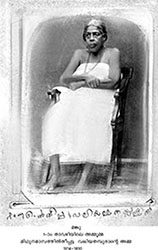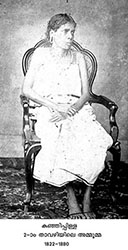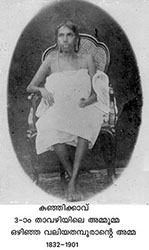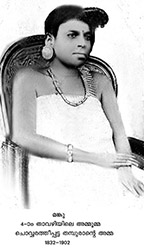In circa 2000, my brother, Kerala Varma Kelappan started collecting data on the family. Combined efforts of several family members, especially S. Anujan Rama Varma and Raghu Thampuran ( Rama Varma) of Kottamukku Kovilakam, has resulted in an Excel Spread Sheet of Genealogy Information, that is being updated regularly. Rameshan Thampuran of Bunglav Kovilakam, with his work,
Genealogy of the Cochin Royal Family , published in 1989. pioneered this effort. I would like to extend my sincere gratitude to everybody who worked towards this and congratulate them for their efforts. The last page on the Excel Spread Sheet names several of the people who have contributed towards bringing this project to fruition.
It is worth mentioning here that I came across a copy of a Geneaolgy Chart in the Matrilineal style, along with the names and regnal dates of Cochin Maharajas, in the British archives . That copy was last updated in 1946-47.
The Genealogy Chart of a Matrilineal family where the Father's names are not mentioned may seem very strange. But, it is not, for those of us who have lived this lifestyle. I am genuinely thankful to note that now, painstaking efforts are being taken to update all that familial information.
Tradition dictates that,
all eldest sons are to be named Rama Varma, the second son Kerala Varma and the third son Ravi Varma. The fourth son becomes Rama Varma. For girls, the eldest was always Amba and later on they started naming the eldest daughter, Manku. The second daughter was always Subhadra ,which later became Kavu. Ikkavu, Kunjipilla, Ikku are all common names. All women and men are adressed as ' Thampuran' while the men take the name 'Varma'.
At the end of the Perumal period, several Swaroopams ( Dynasties) dominated the Kingdoms. What has been written about the Genealogy of those families based on epigraphic data and Grandhavari data may not be authentically verifiable.
When the Portuguese arrived in 1500 .A.D., their initial recorded information about Calicut and Cochin were based on oral history that they gathered from the market place. Yet, that has become meaningful history for us.
At that point in time, there were five Thavazhis ( branches) belonging to Perumpadappu Swaroopam. They were Muringoor or Madathingal, Mutha, Elaya, Chazhiyur ( or Chazhur) and Palluruthy. The senior-most member amongst the five Thavazhis was the Raja of Perimpadappu Swaroopam. The Portuguese insisted that the Raja of Cochin had to be from the Elaya Thavazhy. Thus, they created discord and alienation amongst the Thavazhis.
Over the next 150 years, known as the Portuguese period in Cochin, some of the Thavazhis became extinct due to lack of progeny. The Elaya Thavazhy also ceased to have descendants and adopted from Vettath family, an outsider, even though Mutha, Chazhiyur and Palluruthy had eligible members for adoption. That was cause enough for a Civil War and the Dutch came in, evicted the Portuguese and installed Veera Kerala Varma of the Mutha Thavazhy as the Raja.
Since Mutha and Palluruthy Thavazhys were also in attrition due to lack of progeny, adoptions from Chazhiyur were carried out . From the 18th Century, the Rajas of Cochin have been descendants of the Chazhiyur Thavazhy. In 1715, a 12 year old girl was adopted from Chazhiyur and her descendants constitute the Cochin Royal Family that exists today.
The following chart traces the lineage from the Chazhiyur adoption of 1715 through four women that is, the four daughters of Ikkavu Thampuran, who started the four thavazhis of present day Cochin Royal Family:
*
Chart - The lineage from the Chazhiyur adoption
Pictured below are the four daughters of Ikkavu Thampuran:
Manku Thampuran of Thavazhy one ( CLICK ON Thavazhy one for chart);
Kunjipilla Thampuran of Thavazhy two ( CLICK ON Thavazhy two for chart);
Kunjikkavu Thampuran of Thavazhy three ( CLICK ON Thavazhy three for chart) and
Manku Thampuran of Thavazhy four ( CLICK ON Thavazhy four for chart).



 Click here for more details about the CRF Family Tree.
Click here for more details about the CRF Family Tree.



